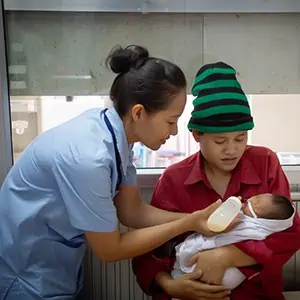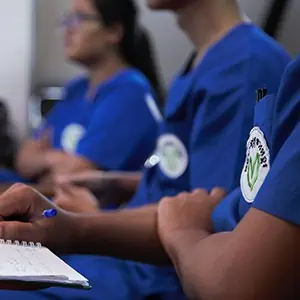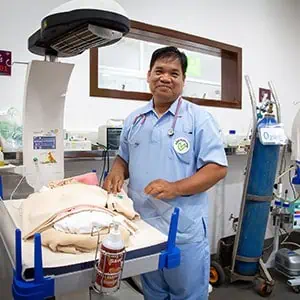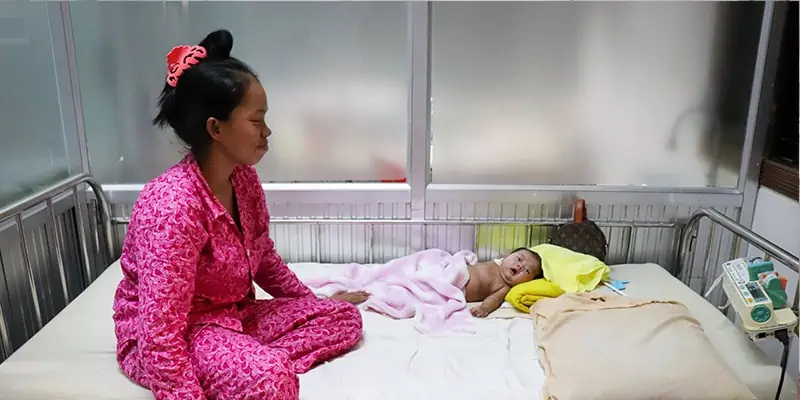One-month-old Samnang arrived at AHC with a methicillin-resistant staphylococcus aureus (MRSA) infection that required intensive and specialised hospital treatment because of the infection’s resistance to several antibiotics, ultimately risking his life.
MRSA is a gram-positive bacterium that can cause pneumonia and other serious infections. The dangerous ‘superbug’ is tougher to treat than most strains of staphylococcus aureus, or staph, infections due to its antibiotic resistance. Staph bacteria is extremely common, three out of every 10 people have it on their skin. Whereas only two out of every 100 people carry MRSA bacteria, although most do not develop MRSA infections. The risk of developing a MRSA infection increases in crowded and unsanitary environments, like rural Cambodian villages, where the bacteria can spread more easily.
Samnang lives with his family in Ta Chranieng village close to the Tonle Sap Lake. His mother, Kannitha, stays at home to care for newly born Samnang and their other three-year-old son, while his father works as a fisherman on the lake. Following years of low and infrequent rainfall, the lakes fishing industry has struggled to remain productive, affecting the livelihoods of hundreds of thousands of Cambodians that rely on the Tonle Sap as their main income and food source, including Samnang and his family.
In October 2020, Kannitha brought Samnang to the Sotr Nikom Referral Hospital where hospital staff recognised the seriousness of his condition. He soon went into respiratory distress requiring emergency resuscitation. Fortunately, hospital staff were able to successfully resuscitate Samnang. He was then intubated and connected to a ventilation machine before being immediately transferred to AHC by ambulance for emergency and specialised care.
On arrival at the AHC emergency room, Dr Sreng Kea, the AHC doctor examining Samnang, immediately recognised signs of septic shock; his low blood pressure, high heart rate, respiratory distress, and high fever. Standard procedure was then followed; Samnang was intubated and connected to ventilation, given adrenaline, a painkiller for the ventilation, vitamin k, and IV fluid antibiotic treatment of meropenem to treat his sepsis. In addition, a blood culture test was taken and sent to the AHC microbiology laboratory for further investigation of his staphylococcus infection.
“If he was brought in one day later he probably would have died. We knew we needed to act quickly and immediately start antibiotic treatment to improve his survival rate.”
Dr. Sreng Kea
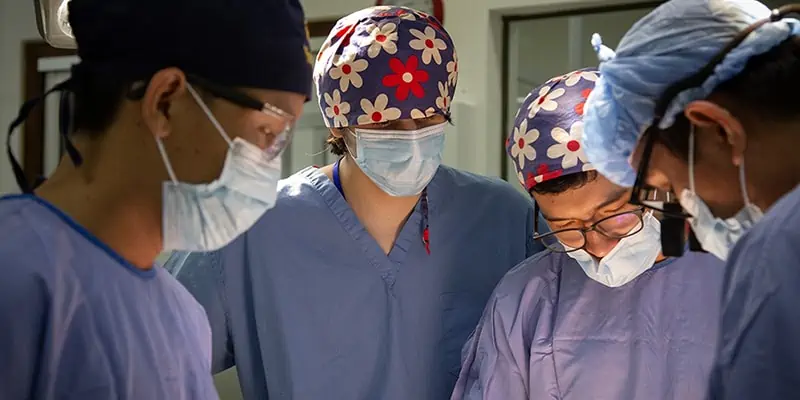
48 hours later and Samnang remained in a critical condition at the AHC Paediatric Intensive Care Unit (PICU). His blood culture tests were returned and revealed Samnang had an MRSA infection that was resistant to the meropenem antibiotic he was being given. Dr Miliya Thyl, AHC microbiologist, explained the correct steps were taken in Samnang’s case despite treatment not working, “From our research, most staph infections, in the catchment area where Samnang lived, are gram-negative and respond to meropenem,” said Dr Thyl, “This is a powerful drug that covers a broad spectrum of infections and is used as front-line treatment in extreme cases such as this.”
The AHC microbiology team recommended a new antibiotic treatment of clindamycin to treat his MRSA infection, which had also spread into Samnang’s bone, causing an osteomyelitis infection. This required different antibiotic treatment of vancomycin and would further extend his stay at the hospital.
Bacterial infections such as MRSA are extremely dangerous in a healthcare setting due to the risk of it spreading to people with weakened immune systems, like those recovering from surgery or another illness. Infection prevention and control (IPC) remains a key focus at AHC to reduce the risk of healthcare acquired infections (HCAIs). All staff regularly attend IPC training and are evaluated to measure IPC compliance. Patients and caregivers are also educated how to prevent bacteria and virus from spreading in-hospital that they can also apply at home.

Samnang’s condition gradually improved after the change in antibiotics. He remained in the PICU for 14 days, needing eight days of ventilation treatment, followed by three days of CPAP treatment. It was a further 11 days until he stopped vancomycin treatment for his osteomyelitis infection. Samnang was then moved to the AHC Inpatient Department (IPD) to recover fully from his illness.
According to Dr Kea, the colonisation of Samnang’s MRSA infection was most likely acquired from birth or the rural environment in which he lived for the first month of his life. “These children are exposed to bacteria and viruses on a regular basis,” said Dr Kea, “We are trying to educate parents to keep their homes sanitary and also to seek healthcare immediately when their child is sick, because there is a chance it can be a nasty bug like MRSA.”
Coming from a poor and rural area, Samnang’s mother Kannitha had limited knowledge of newborn care. She said she was unaware of the signs of a sick baby and did not know what was wrong with her baby. “Now I understand that poor feeding and high fever are serious signs of sickness,” said Kannitha, “I will take my son to the doctor much sooner next time.”
Samnang needed over three weeks of hospital treatment before he was strong enough to return home. He was given every chance of survival by AHC’s team of experts, the emergency room/PICU team providing critical and specialised treatment, the microbiology staff detecting dangerous antibiotic resistant infections, and the medical and nursing staff educating caregivers how to care for, and prevent illness, in their children. Through this high quality and specialised care, AHC hopes to reduce the risk of serious cases like Samnang’s from occurring in the future.
